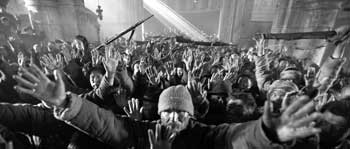 Back to selection
Back to selection
H2N Pick of the Week
Weekly reviews from our friends at Hammer to Nail by Hammer to Nail Staff
City of Life and Death — A Hammer to Nail Review
 (City of Life and Death opened on May 11, 2011 at Film Forum in New York City. Learn more at the film’s official website.)
(City of Life and Death opened on May 11, 2011 at Film Forum in New York City. Learn more at the film’s official website.)
In December 1937, China’s capital city Nanking fell to the invading Japanese Imperial Army. During the weeks that followed, the Japanese raped, tortured, and butchered the city’s remaining inhabitants; the death toll varies widely, but some estimates put it at over 300,000. Lu Chuan’s epic film, which screens at Film Forum through May 24 and in select U.S. cities after that, dramatizes the Nanking Massacre (also known as the Nanjing Massacre) from multiple perspectives. The major characters include a small band of soldiers struggling to resist the invaders; a German businessman (based on the real-life John Rabe) and his Chinese associates, who establish a safety zone to protect the citizens of the city; a Japanese sergeant whose fundamental decency is ultimately no match for his compatriots’ brutality.
Although the bloody historical epic commemorating a pivotal national event has long been a staple of world cinema — cf. The Birth of a Nation and Potemkin, for starters — Lu seems to be most directly channeling the Spielberg who made Schindler’s List (for its blend of shockingly graphic violence, big-topic solemnity, and populist sentiment) and Saving Private Ryan (for all of the above, plus a hefty borrowing of battle-scene tricks). In the film’s strongest moments, Lu measures up to his model; City of Life and Death is a harrowing, wrenchingly emotional experience, rendered with masterly cinematic skill. The viewer is shunted from one brain-scalding, bone-chilling scene to another: Chinese POWs herded by the hundreds into mass graves and buried alive, a crying child hurled out of a window to its death, the tangled limbs of dead “comfort women” heaped into a wheelbarrow. All this — or something very close to it — actually happened, and Lu deserves praise for making a big-budget mainstream movie that attempts to face up to the worst that people are capable of.

Which is not to say the film doesn’t run into some of the limitations inherent in that approach. City leavens its scenes of cruelty and carnage with moments of sacrifice, nobility, courage — these too may be taken from the historical record, and are part of the human story of any war, but they’re a commercial requirement as well; the movie had no chance of being made without them. (A thought-experiment proposed by Stanley Kubrick, as reported by Frederic Raphael: Was Schindler’s List really “about” the Holocaust? “The Holocaust is about six million people who get killed,” said Kubrick. “Schindler’s List was about six hundred people who don’t.”) And it’s in those moments, when the sound-and-vision barrage of Lu’s technique loosens its grip on our throats, that we’re reminded of a thousand other sentimental scenes in a thousand other movies. The looming, tearful close-ups, the tasteful string music in the background, the hero’s defiant last words before the firing squad, the child whose shining face at story’s end represents the hope of better days to come… City is full of scenes like these, and they don’t all play well, and when they don’t, the spell is broken, the fourth wall crumbles, one’s mind begins to consider the AD work that went into marshaling the thousands of extras, the pressure on the actors to cry at just the right moment during an impossibly complex long take, the script conferences that hashed out how many scenes of atrocity versus how many scenes of uplift, and so on.
It’s only a movie, after all — a banal observation, but perhaps the most interesting thing about City of Life and Death is that it’s just one sally in a larger and more vital conversation, about history itself and the uses to which it’s put. To this day, the Nanking Massacre remains a much-debated topic in Asia. The Chinese government has been accused of relentlessly propagandizing the event to stoke nationalist sentiments (and to draw attention away from the CCP’s own crimes against its people), while Japan’s official acknowledgments of the massacre have been half-hearted and halting, with many prominent politicians denying that it even took place. Lu and his film have landed in the middle of the controversy. City was a box-office success in China, but the director received death threats from fundamentalist-patriot types incensed that he depicted the Japanese sergeant in a sympathetic light. Meanwhile, on the global cinema circuit, the movie is sure to be met with many a skeptically raised eyebrow: since the Chinese authorities granted their support to the film, will it be judged as an individual work of art, or must it be viewed through the lens of the “message” it sends about China, its past, and its present place in the world? (Consider the paradox that City deals with a great national defeat, and yet only a wealthy, powerful country with a thriving film industry could possibly produce a movie on this scale. The film is a tragedy, but its very existence is a kind of triumphalist statement.) So maybe the real story begins where City ends — which is all the more reason to see it. For all its flaws, it’s an urgent, impassioned, necessary work.
Filmmaker has partnered with our friends at Hammer to Nail for a weekly “Pick of the Week” post that will be exclusive to our newsletter and blog for a long weekend, at which point it will go live over at Hammer to Nail as well. In the meantime, be sure to visit www.hammertonail.com for more reviews and lots of other great editorial.
